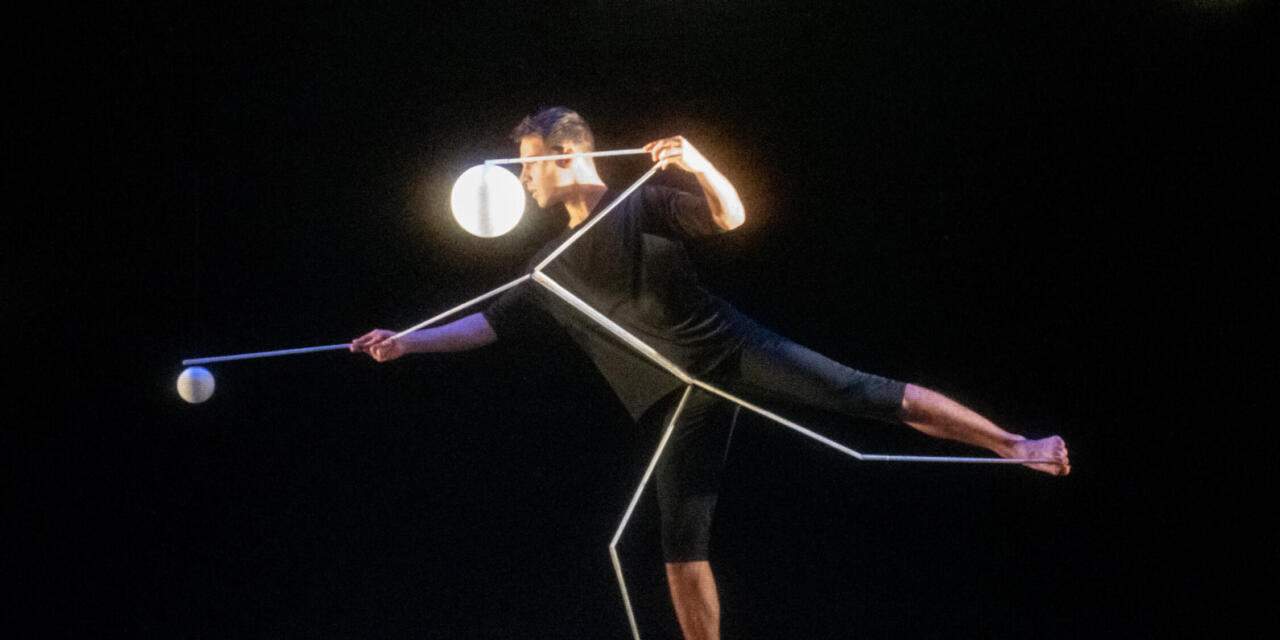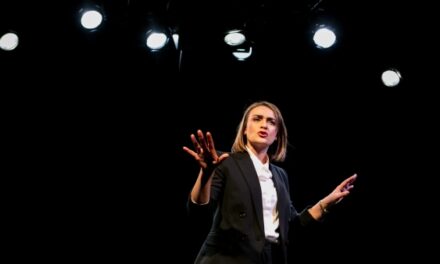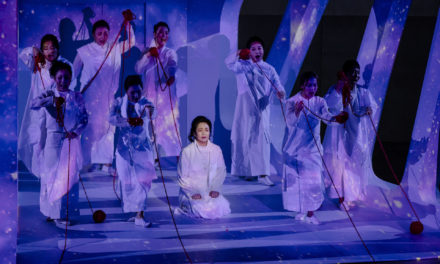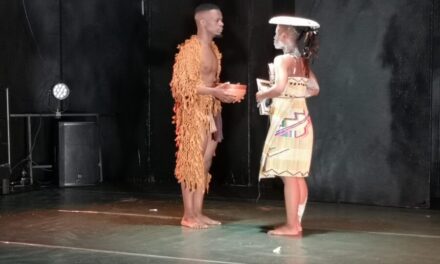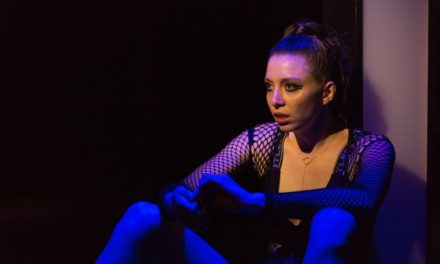The second Novi Sad Theater Festival again provided an exciting seven-day festival repertoire for children, and young people, as well as sensitive enjoyers of refined, gentle, and irresistible theater. The city of Novi Sad hosted twelve plays, which were reciprocated with superb performances in the “Youth Theatre” in front of the youngest and most important Novi Sad audience. Theater artists arrived from various countries and regions including Serbia, Macedonia, Slovenia, and Croatia, but also Germany, Spain, and Israel. The greatest puppeteers, animators, and actors, as well as all the theater creators hidden behind the scenes, using miniature sets and wooden dolls of girls, boys, animals, clouds, and shapes, built a new and better system of values in front of our eyes with their theatrical expression, talent, and skill. They told a didactic life story in their own way, sometimes a fairy tale and sometimes a harsh truth, enchanting the festival audience with their art and aesthetics.
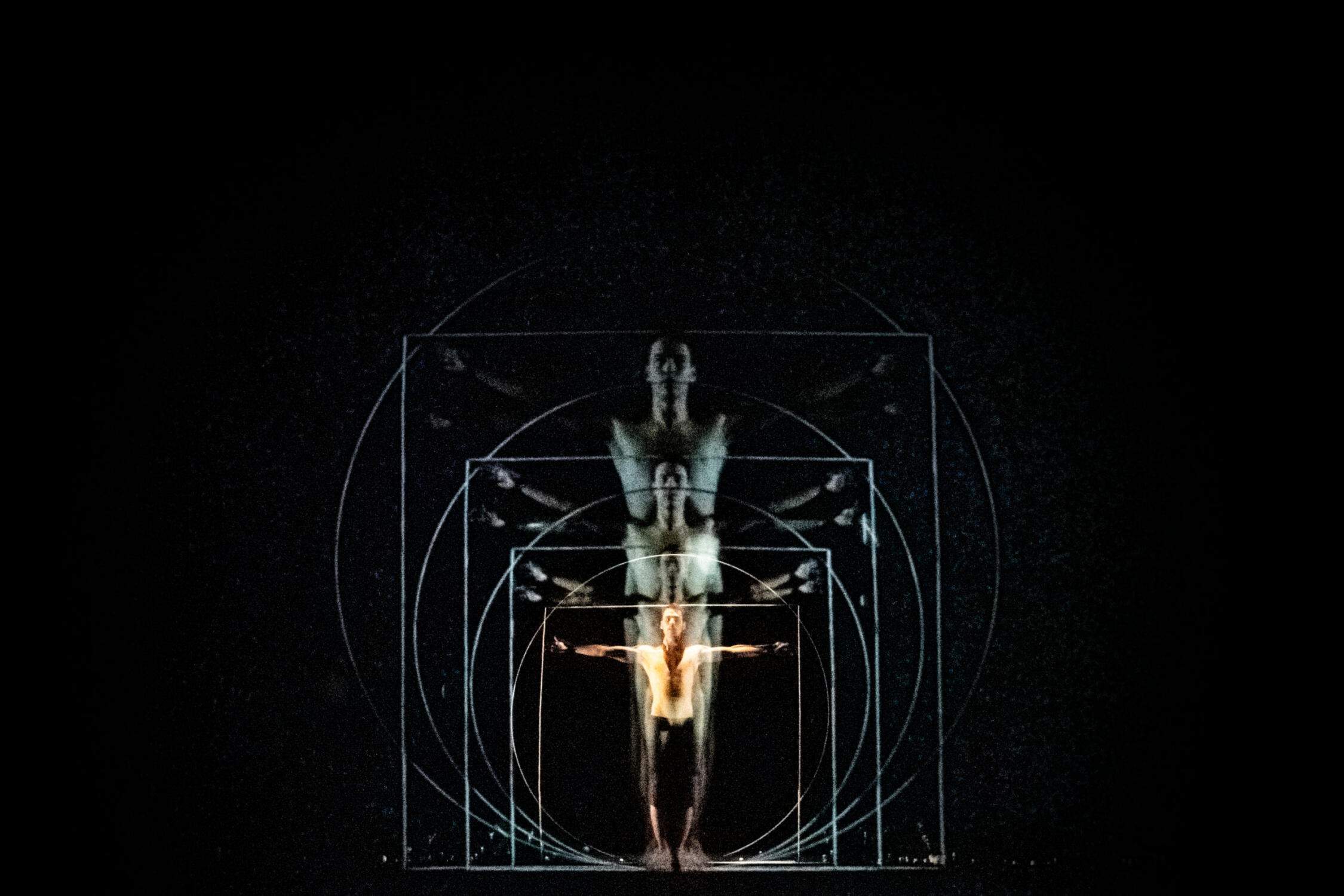
Theatro Plus, Geometry of the Soul. Press photo
Geometry of the Soul, a performance by the professional theater of puppets and marionettes Teatro Plus from Gijon, Spain, directed by Olga Zeceva, emphasizes the experimental in theater for children and young people. In the performance, an abstract geometric concept connects with the essence and spirit, which represents that truthful line that distinguishes, separates, and elevates a person above everything else. An artist who performs an entire show, inventor of ideas and creations, actor, dancer, and animator, Alek Churchich, with his talent and skill, develops a mathematical formula, a geometric basis, and artistic enthusiasm in front of the audience.
For The Theatre Times Churchich said: “For me, Geometry of the Soul is a very personal and sincere project that was sparked by a simple desire for experimenting and rediscovering materials as simple as spheres and sticks. It may have a deeper meaning now and a lot of elements in it, but all of them are built from this impulse. I have done what I can to listen to the materials I have worked with and to keep that spark with me from the beginning up until today.”
The connection between man and nature, scientific and artistic, represents the cosmic essence in a unique way, where a circle begins to resemble a womb, a cube a prison cell, a curved line a bird’s wings, a series of balls, the real and illusionary, a visit to a planetarium or a feeling of being among the planets in the galactic expanses. Meanwhile, the arranged, broken lines resemble a human body searching for a head. A new form is designed with lines every moment, through which human blood flows and beats the person’s heart. The play of light and shadows, stage and costume minimalism imitate the primordial theater with a dark background and bright events that provide freedom for full imagination. The three-dimensional setting, the collision of special visual effects with the actor’s elegant selection of stage movements and theatrical play created within, evokes an infinite straight line, a line defined by the length, and in this case, that line created width by itself. The law of proportion, the collision of measure and form, in its foundation, contain a creative function that transfers to the history and philosophy of everything that exists, but above all – to the aesthetics of the creative setting. The numerous artists of this play wholeheartedly construct the Squaring the circle in the triumphant finale – square, in it a circle, and inside of it, is a man. What a pen dipped in ink created in the notebook of the Renaissance artist Leonardo da Vinci in the fifteenth century is reborn on the stage in the twenty-first, from the form of a being in perfect proportions emerges the Vitruvian Man. The figure of a man in two overlapping positions, in the Golden ratio, rounded off the entire performance, draws out the complete “Geometry of the Soul”. The play won the Special Award for overall impression at the Second Novi Sad Theater Festival.
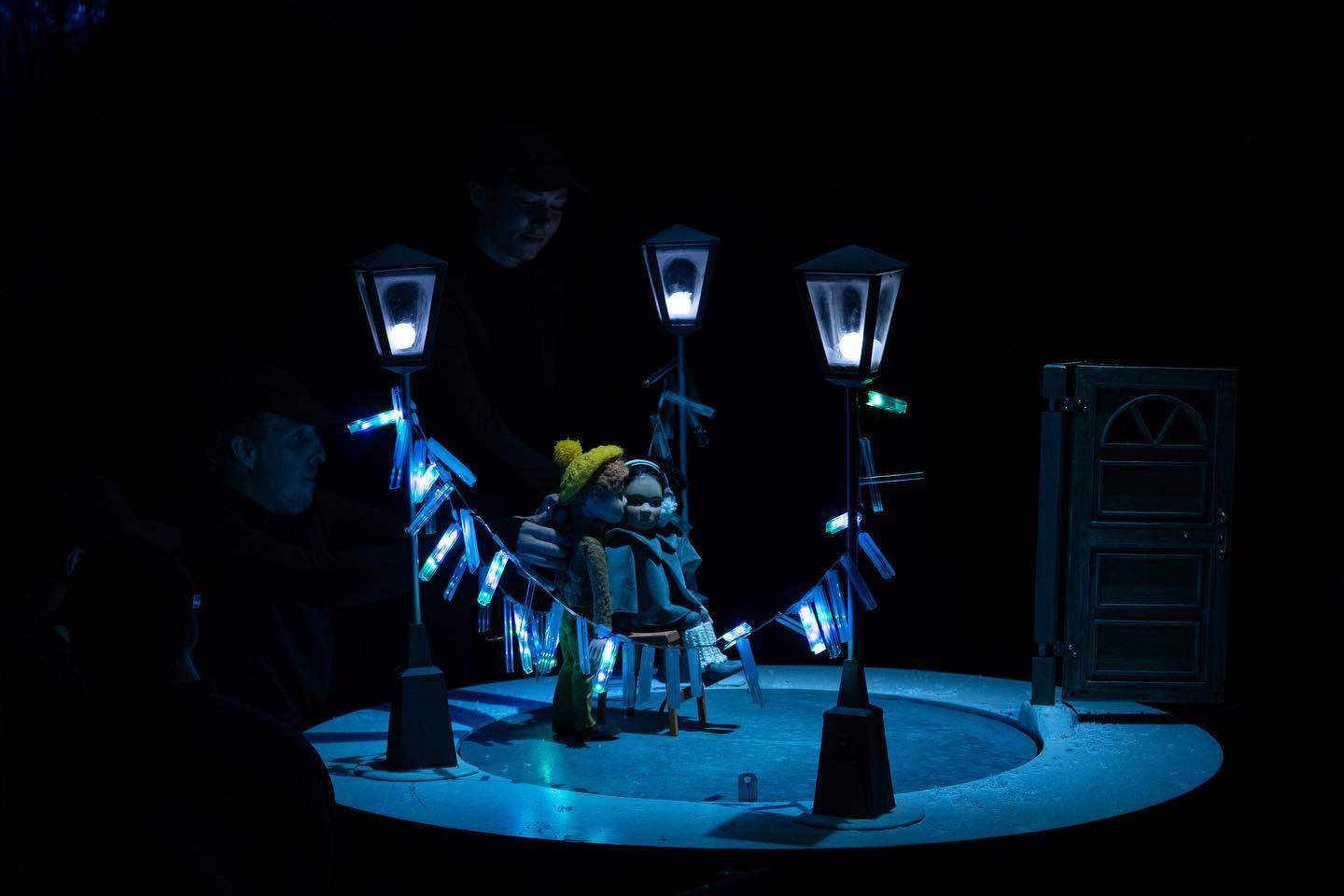
Frozen Songs. Photo credid: Jovana Berar
The performance Frozen Songs by the City Puppet Theater from Rijeka, Croatia, with its polar landscapes and hidden secrets of the heart, fascinated the youngest audience, who carefully followed the miniature stage rotation and exciting movement of the puppets, created by Alena Pavlović, together with Luča Vidanović. The small spectacular show and the author of the text and director Tamara Kučinović design an atmosphere based on the motifs of short stories by Stepan Pisakhov.
The puppet show takes us to freeze remote areas, places of eternal winter and cold with temperatures down to minus seven hundred degrees and the magical glow of the polar light. In such a town lives a boy named Kostya. Suddenly, there appeared a little girl with the most beautiful black curly hair who had traveled with her father from Europe. Butterflies appeared in Kostya’s stomach, he wanted to know the girl’s name at all costs, but the shy girl did not speak for some reason, maybe because she was cold – that is what Kostya thought first. But the problem seems more severe – the loss of her mother. A boy does everything to befriend a child whose name he doesn’t know, bringing her gifts daily and making her laugh with his word puns. Although the girl saw in Kostya – a compelling boy and a kind being, she did not speak at all due to her sadness. Nevertheless, Kostya’s great love and perseverance led to the frozen words melting like icicles, which turned into songs by a girl name Katya. Skillful puppet ensemble consisting of Tilen Kožamelj, Petra Šarac, Damir Orlić, David Petrović, and Andrea Špindel successfully brought to life a tender, quite difficult, dark and sad story, turning it into a triumph of love.
“My need was to speak about the power of love, patience, and tenderness. I wanted to tell the children that no matter what difficult thing they went through, there is someone who will love them and with whom that wound will heal more easily. I built a tender and witty play so that every child who needs it can open up again after that.” – the director Kučinović told The Theatre Times.
The audience received the play with complete trust and understanding, with great empathy, and the jury awarded Frozen Songs and its ensemble a Special Award for collective play and animation, as well as the award for best direction.
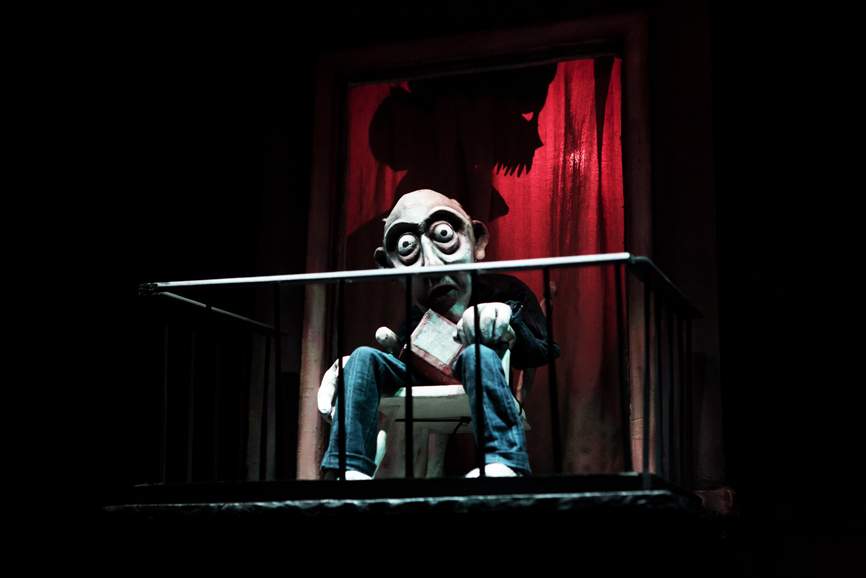
Merlin Puppet Theater, Clown’s House. Press photo
“The Cap and Bells of Time the Clown
That, jangling, whistled down
Young cherubs hidden in the guise
Of every bird that flies;
And star-bright masks for youth to wear,
Lest any dream that fare
—Bright pilgrim—past our ken, should see
Hints of Reality.”
– Clowns’ Houses by Dame Edith Sitwell
The Merlin Puppet Theater from Berlin, Germany, with its show Clowns’ Houses intended for children over the age of fifteen, puts on stage a significant experience of watching theater for adults in the form of a puppet children’s toy. Founded in 1995, Merlin Puppet Theater was located in Athens (Greece), then in the year 2011, moved to Berlin (Germany). As a part of their work for the theater, Dimitris Stamou and Demy Papada began making masks and puppets after which they started performing their works for children and adults. The authors and animators Dimitris Stamu and Demi Papada presented a (sur)real image of society through a small theatrical portal, a world of the grotesque, a present from which the action of unpleasant life events unfolds and overflows.
The story places us in a residential building with five apartments where different people live, unique and unhappy in their way. Each apartment represents a singular verbal act, an artistic image, and a short theatrical scene with an independently developed plot. The first picture introduces us to the living room of a lonely man in front of the television, the second to the apartment of a hysterical housewife with a vacuum cleaner, the third to the terrace of a pensive father with a radio in his hand and the sounds of his wife and children in the background. The fourth scene allows us to peek through the keyhole into the office of a greedy businessman who only fantasizes about money, while the last scene takes us to the roof of a building where the Punk and the girl meet in their misery.
The change of space and characters of human decay is marked by auditory content, where the audience sits in the dark and listens to the poem by Dame Edith Sitwell, after whom the play got its name. The poem “The Clowns’ Houses” intensely mocks civilization by comparing all people to clowns as ridiculous and empty beings, deeply disordered and unhappy inside. What is thought to be a mask will turn out to be a face. People are puppets. Claustrophobia, narrowness, and meaninglessness of life give rise to brain boiling and produce complete numbness, ultimate dehumanization. Objects begin to overpower their owners. A woman gets strangled by a vacuum cleaner, a television enters a man’s head, and a businessman has coins coming out of his mouth. Many theatrical techniques change, a play of shadows and marionettes, music that penetrates the veins resounds, the terrifying lights of the television screen, an old refrigerator, street lamps, complete madness that reigns in these houses – dungeons of souls among their inhabitants, monstrous dolls and introduces us to a dark dystopia with elements of black comedy. Where and when did it all go wrong? The play empowers young viewers not to allow themselves such setbacks to fight against being monotone and habitual.
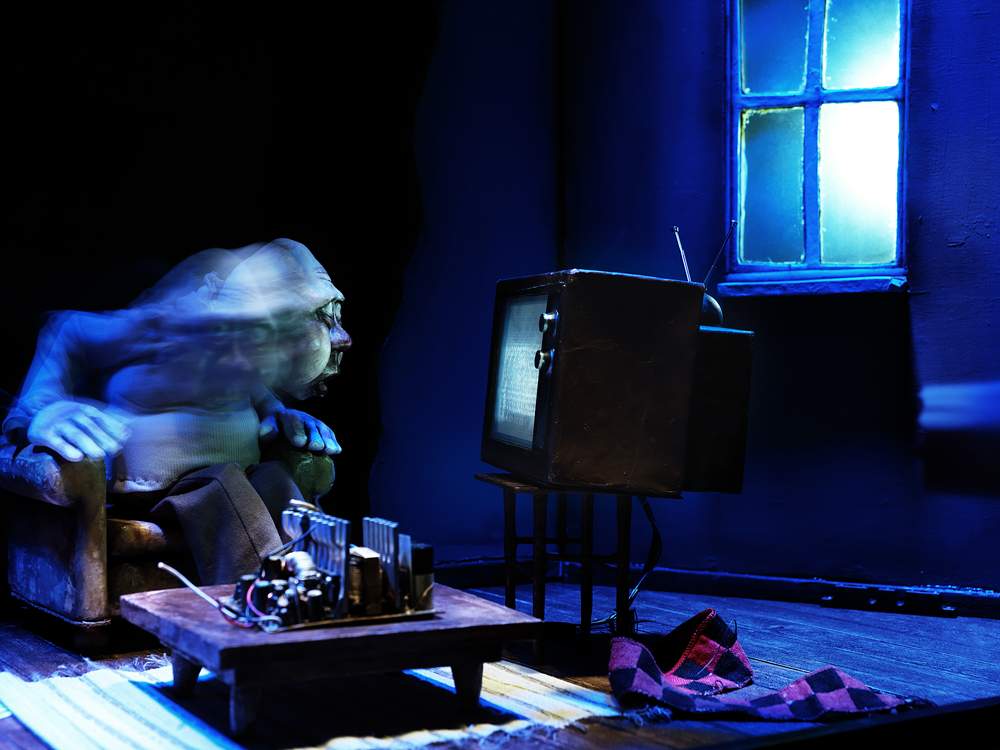
Merlin Puppet Theater. Clown’s House. Press photo
The jury awarded a special award for authenticity and originality to this performance and The Merlin Puppet Theater said the following for us: “With Clowns’ Houses we are trying to create a representation of modern society in the puppet language. Our goal was to build universal characters and stories on stage, that highlight the common human behavior, globally. By using puppets and dramatizing these stories, we succeeded to create a show that opens a theatrical dialogue with the audience. A dialogue about our pathetic way of life, our obsessions, and our loneliness. Looks interesting to us, after 400 performances in more than 45 countries, how this approach is so common and familiar, to all people, regardless of country, culture, or social status. For us, the theater must be a dialogue, “Art has to be a hammer” as Brecht said. We don’t want to move the finger to the audience, in fact, nor to pass a message. We want to talk, to arouse problematics and emotions, to share thoughts and experiences through theater.”
This post was written by the author in their personal capacity.The opinions expressed in this article are the author’s own and do not reflect the view of The Theatre Times, their staff or collaborators.
This post was written by Emilija Kvočka.
The views expressed here belong to the author and do not necessarily reflect our views and opinions.

